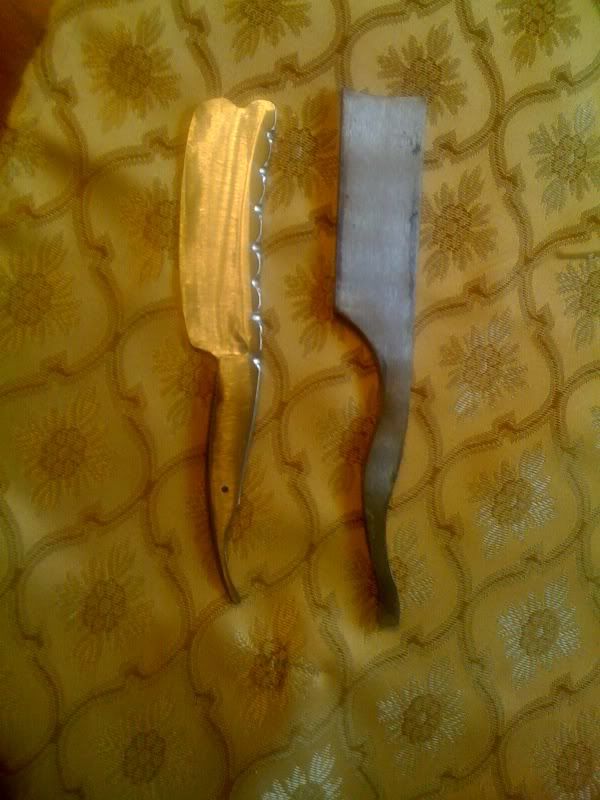Results 31 to 40 of 143
Thread: An experiment in steel
-
12-31-2009, 10:14 PM #31"My words are of iron..."


- Join Date
- Oct 2006
- Posts
- 1,898
Thanked: 995
I didn't say copper and bronze were the same as iron or steel. Even though the history books say they were Bronze Age or Iron Age, there was considerable overlap of the types of materials used in blades during both time periods.
The ancient metalworkers who had the knowledge of how to work copper or bronze would have tried them out on the iron and steel as well. For that matter, there are some museum bronze blades that are harder than iron blades from the same time period as a result of work hardening.
Last time I dug around in the work-hardening materials book, it was possible to bring a manganese steel up to about 600 Brinnell from work hardening alone. It helps if it's a work-hardening steel like this, but even steels without manganese will harden some from cold deformation.
Here's the conversion chart: Maryland Metrics: Hardness Conversion Chart You have to figure out for yourself it's a useable hardness.“Nothing discloses real character like the use of power. Most people can bear adversity. But if you wish to know what a man really is, give him power.” R.G.Ingersoll
-
01-01-2010, 06:38 AM #32

Regardless, the information here is looking good.
My question is: can I make a decent razor with a bare bones setup.
and all of you are helping.
Hopefully I will be ready to do my heat treat in the next few days, I almost have a forge made...
and next comes the finish work.
I don't expect to make a Zowada or a Williams, but if I can shave with it, this experiment will be a success.
-
01-01-2010, 07:15 AM #33Senior Member

- Join Date
- Jan 2008
- Posts
- 701
Thanked: 182
your good
dont worry keep the shop dark adn wait for ther shadows to dance on first run just pull out the steel
the 2nd run watch hotthe steel comes up to teml
and whe you see the shodows dance give a sec and then pull and quench
with yur edge being waht it is i can only hope for you but if you have a 2nd blank thats a hair thicker then i feel there ias hope
-
01-01-2010, 02:22 PM #34"My words are of iron..."


- Join Date
- Oct 2006
- Posts
- 1,898
Thanked: 995
It's all good.
What you need to know, you are on the right track. The rest of this is all good to know or nice to know.
Where the rubber meets the road is, you with your hand holding the tongs, holding the blade in the heat and just breathing and watching the blade come up to temperature....lots of stuff going on to see. The steel will teach you a great deal. O-1 is a great teacher.“Nothing discloses real character like the use of power. Most people can bear adversity. But if you wish to know what a man really is, give him power.” R.G.Ingersoll
-
01-01-2010, 09:53 PM #35

I think I'm going to grind some more off the shank on my first blank, so if I do have to grind away some warpage it won't look wrong...
My second blade is going to be a bit smaller (6/8 or 7/8), and thicker. The first is closer to 8 or 9/8ths.
-
01-02-2010, 12:41 AM #36

What technique do folks use to keep from burning the carbon off
the thin part of the blade when heat treating and tempering.
Obviously one is to have an oxygen starved furnace.
-
01-02-2010, 02:44 AM #37
-
01-02-2010, 03:26 PM #38"My words are of iron..."


- Join Date
- Oct 2006
- Posts
- 1,898
Thanked: 995
Mike: yes, if you don't protect the blade from the atmosphere inside the forge. The correct term is DE-carburized but you have the idea. Leaving the edge thicker before heat treatment is the trick for both decarb and warpage. Warpage is better addressed in the preparation of the steel before heat treatment but that is a whole nother issue. Work this blade first.
There is a fine tradition of using a simple clay coating to prevent the fire atmosphere from burning the steel.
Depending on your ability to control your fire (the reduction atmosphere = no oxygen) there is a trick that can be done with an iron pipe. Black iron now, not the zinc coated galvanized stuff, unless you want to poison yourself. Seal one end of the pipe and stick the whole pipe into the fire and bring everything up to temperature. Right before sticking the blade into the pipe, where it should be all nice and hot and the same color as the rest of the fire...throw in some smallish pieces of charcoal. The charcoal will consume the excess oxygen in the much smaller diameter of the pipe.
There is a product out there from Advanced Technical Products...it's called Anti-scale coating. Very good stuff for exactly the purpose you describe.“Nothing discloses real character like the use of power. Most people can bear adversity. But if you wish to know what a man really is, give him power.” R.G.Ingersoll
-
01-02-2010, 10:53 PM #39

I have some bentonite clay I think I'll use on the first blade to prevent losing anymore steel on the edge, and hopefully prevent some warping...
I have the second blade profiled and the pivot hole drilled, so I'm getting close to the heat treat...
My suggestion to anyone who wants to try this, is get a decent belt sander...
The grinder works but is extremely slow to cut...

-
01-04-2010, 02:27 AM #40


second blade almost ready... much thicker than #1
My furnace is done, and I will post it's picture next...



 LinkBack URL
LinkBack URL About LinkBacks
About LinkBacks






 Reply With Quote
Reply With Quote



